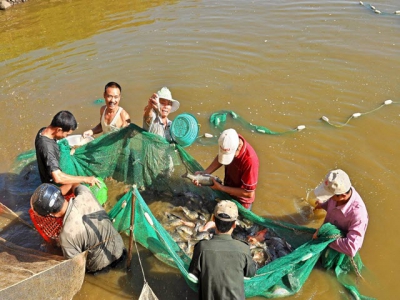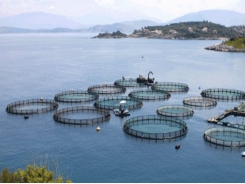Difficulties challenge aquaculture development in the north

Despite its great potential, aquaculture development in Vietnam’s northern provinces is facing difficulties and challenges in terms of marketing, capital mobilization, scientific-technological application, seed and chain connectivity.
Freshwater aquaculture remains small-scale and scattered
According to the Directorate of Fisheries’ Department of Aquaculture, the northern provinces are home to 224,800ha of aquaculture, accounting for 21.5 percent of the country’s total, of which the fish farming area represents 52.8 percent, the shrimp raising area - 4.3 percent, and the mollusk breeding area - the remaining 42.9 percent.
The northern coastal provinces possess favorable conditions to farm such valuable seafood as black tiger shrimp, white-leg shrimp, Epinephelus, and barramundi, while provinces in the northwest, northeast and Red River Delta are well suited to farm freshwater and cold-water fish and develop aquaculture in large-sized dams and reservoirs for the domestic market and export.
However, aquaculture development is encountering difficulties related to inadequate infrastructure, small-scale and inconsistent production, and capital shortages. Tran Dinh Luan, Deputy Director General of the Directorate of Fisheries said the government should invest in upgrading aquaculture infrastructure and enable aquaculture projects to access preferential credit.
In addition, farmers should be provided with aquaculture training and models for application of science and technology to aquaculture, and the government should stimulate trade promotion, remove trade barriers, and develop the domestic market.
Nguyen Tu Cuong, head of the Vietnam Fisheries Society’s Sustainable Fisheries Development Board said all stages of production must be safe and controlled by chain. Vietnam has signed 12 free trade agreements (FTAs), which all address sanitary and phytosanitary (SPS) measures, and therefore the application of production and sales chains and good aquaculture practices are vital for sustainable aquaculture development, he said.
Dr. Tran Ngoc Hung from the Institute of Management for Agricultural and Rural Development (IMARD) said fisheries have a high competitive advantage, huge development potential and fast production and export growth. However, financial policies for fishery chains need to be improved, Hung said.
Related news
Tools

Phối trộn thức ăn chăn nuôi

Pha dung dịch thủy canh

Định mức cho tôm ăn

Phối trộn phân bón NPK

Xác định tỷ lệ tôm sống

Chuyển đổi đơn vị phân bón

Xác định công suất sục khí

Chuyển đổi đơn vị tôm

Tính diện tích nhà kính

Tính thể tích ao



 Việt Nam has opportunity to boost white-leg shrimp…
Việt Nam has opportunity to boost white-leg shrimp…  The seafood companies push export turnover in the…
The seafood companies push export turnover in the…